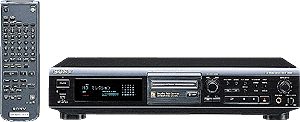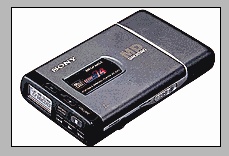Review of the Sony Minidisc Bundle3
by Bruce Winegar ([email protected])
Introduction
The Sony Minidisc Bundle3 consists of two components bundled together
along with two 60 minute blank minidiscs. The central component of the
package is a minidisc deck (Model MDS-JE500) which has record/play
capability with both digital and analog in/out jacks. The portable
minidisc player (Model MZ-E40) cannot record. The concept of the bundle
is to provide the user with a package for recording music that can be
listened to at home as well as on the go with the portable player.
Accessories included with the recording deck are two RCA-type stereo
cables and a rather elaborate remote control. The player comes with a
set of open-air headphones (Sony MDR-24) and a snug-fitting leather
pouch with slots to hold the player in place on one's belt.

The MDS-JE500 Minidisc Deck
This recording instrument was designed to allow the user to perform
complex recording functions with minimal confusion. The unit itself has
a simple, elegant "black box" design, but is suprisingly small and light
for a home audio component. I'm sure Sony could have made it much
smaller if they wished. The design and controls follow a logic which is
easy to learn and understand. The instruction manual is clear and
concise. I recommend that it be read before using this unit. Although
many users will probably be experienced with data storage and management
on a computer, they may be pleasantly surprised (as I was) to suddenly
have all the inherent advantages of digital technology suddenly
available for home audio recording. Want to erase a track? No problem,
just enter the command and it's instantly gone, as if you were trashing
a file on your PC. You can even change your mind and recover it, as long
as you haven't ejected the disc or recorded over it. You also have the
capability to name each track and name the disc itself, although the
labeling process is a little tedious with the available controls. And
because you are recording on media with random access capability, you
never have to rewind. Using this machine may even start to change your
concept of what music is. Music is handled like a file in a computer -
and is more accessible and more manageable than ever before.
When inserting a minidisc, the machine grabs and loads the disc in the
same way some computers handle diskettes. The display then reads
"WELCOME" as it reads the minidisc directory. Press the record button
and input signals now register on the stereo LED amplitude meters so
you can adjust the gain. Sony has eliminated the ability to
individually adjust the left and right channels, providing a single
gain knob that controls both simultaneously. While there is only a
single recording speed available, the recording time can be
approximately doubled if you record in monaural mode. After pressing
record, the machine enters record-pause mode and can remain there
indefinitely. At the same time, it assigns a track number to the
recording session. After recording begins, when recording with digital
input, new track marks are read along with the audio information from
the CD. This way you can record a CD and the track divisions on the
minidisc will match the track divisions on the source CD. But when
recording with analog input a new track number is marked when a low
audio signal is detected that persists for at least two seconds. This
automatic track marking function works nicely, but on occasion it may
assign extra track numbers to a single piece of music that contains
very quiet passages. However, this is not a problem since the
recording itself is continuous and track marks serve as a tool to
identify and map the recorded music. After recording, tracks can be
combined, divided, moved, or erased with simple commands - a process
which I found to be fun and is completely unique to the minidisc
format. For example, if you are recording a set of tracks to play for
a party, you can edit out the periods of silence between tracks by
splitting them from the music and then erasing the silent sections.
Sony has developed an editing feature that uses the automatic music
sensor (AMS) knob for fine positioning, using this you can move edit
points in 60 ms increments, making it possible to end a track just at
the last chord, then repeat the process at the start of the next music
selection so it will begin precisely on the first audible note. With
the edit features, it's possible to produce music programs where the
tracks seamlessly merge with one another without artifactual noises or
distortions which would normally be present when using analog tape.
The MDS-JE500 records music which to my ears is indistinguishable
from the original source. I listened to classic, reggae and jazz works
recorded from CD on the analog input. Speaking qualitatively, in every
case the minidisc copy contained no distortion and did not sound
different from the source. I did hear differences on the first
consumer minidisc players that were introduced, but Sony has now
refined the ATRAC coding algorithm to a point where the user will not
hear perceivable differences. As expected, the specifications for the
MDS-JE500 are impressive. The frequency response is 5 - 20,000 Hz +
0.3 dB. The signal-to-noise ratio is over 96 decibels. There is no wow
or flutter. This makes the minidisc an attractive medium for archiving
out-of-print vinyl LPs, reel-to-reel tapes, and music recorded on
other older formats. But beyond all the advantages of digital
recording, the real power of the minidisc is the capability it gives
you to listen to source-equivalent recordings virtually anywhere.

The MZ-E40 Portable Minidisc Player
Imagine a box the size of a calculator (OK, say two calculators taped
together) in which you can plug your headphones and hear music with
the same fidelity as your home stereo. This is the MZ-E40. Although a
portable CD player offers the same level of listening enjoyment, it is
not nearly as portable nor can you listen to your own music mix on
one. The MZ-E40 takes music portability into a new dimension, allowing
you have the music you want when jogging, doing aerobics or a
free-weight workout, skiing, or any other high-energy (but dry)
activity in which portable CD players would definitely impede your
performance. The controls and display of the MZ-E40 are all at one end
with a few less-used controls located on the back. The vertical design
of the MZ-E40 is such that when operating it you may look a little
like Mr. Spock adjusting his tricorder. You can precisely control the
volume with buttons that make adjustments in about 5 dB increments.
Although the maximal volume level is definitely not as great as with
most portable audio components, it is certainly loud enough to satisfy
most persons who are not unconcerned about preserving their hearing.
Sony has included a switch selectable automatic volume limiting system
(AVLS) that keeps the user from being able to set the volume above a
predetermined and unchangeable
level which they apparently consider to be loud but safe. While I
appreciate the concern of Sony for my hearing, I have not yet found
this switch to be of much utility. The amplifier includes Sony's
Megabass circuit, which can be switched on from a control on the back.
One can move from track to track by pressing the double-arrow marked
buttons or move within a track by holding down on these same controls.
A switch on the back of the unit allows you to shuffle the tracks,
play a single track repeatedly, play the minidisc repeatedly, or
simply play the minidisc once in the order of the numbered tracks. The
display shows you the track number, the title, and the playing time.
The unit is powered by two AA batteries or by an optional line
transformer, which can charge batteries in the unit as well. Playing
time is limited to about three to four hours with the batteries. I strongly
advise anyone who buys this player to also get a set of rechargeable
batteries and a charger in order to avoid spending a small fortune on
disposable batteries. One minor incongruity with the otherwise
flawless design of the two minidisc components reviewed here is that
for some reason, Sony has placed the spring that normally contacts the
negative end (flat end) of the battery on the side that contacts the
positive end (nippled side) of one of the two battery slots. But even
this feature starts to make sense on further reflection, when one
realizes that this allows you to insert both batteries easily from the
same side. This approach illustrates how Sony has paid attention to
even the most minute detail in the design of these audio components.
The Minidisc
The minidisc itself looks like
a transparent diskette in which a miniature CD has been placed. It
measures about 70 mm on a side (a little less than 3 inches) and is
roughly 4 mm thick. Two sizes of recordable minidisc are available,
one with a recording time of 60 minutes (such as those included in the
bundle), the other providing 74 minutes. Datawise, minidiscs store
about 140 Mbytes of information, using magneto-optical recording
technology to produce a recording much more resistant to stray
magnetic fields than any kind of magnetic recording technology,
including DAT. Unlike a computer diskette, you can't open the casing
and look directly at the enclosed minidisc. Apparently, the minidisc
is too vulnerable to dust and scratches to allow direct exposure to
the environment. However, if you hold one up to the light you can see
a beautiful rainbow, similar to what a CD produces. But apart from the
esthetics of the medium, the minidisc is so small that you can easily
put 5-8 hours of digital music in your pocket as you take your
minidisc player along with you on your adventures.


